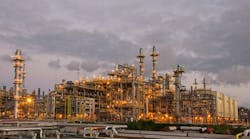This year is expected to continue to be a banner year for US natural gas, with growing consumption, exports, and production (see table, p. 30). In addition, a colder-than-normal winter resulted in larger inventory withdrawals than a year ago.
OGJ forecasts that marketed gas production will reach 87 bcfd this year, a sizeable increase from last year’s 79 bcfd. The substantial growth in production is driven by activity in the Appalachian region, associated gas recoveries, the coming online of previously drilled but uncompleted wells, and improved well performance.
An enormous potential takeaway capacity growth in Appalachia is in sight. By yearend, if all new pipeline projects come online by their scheduled service dates, more than 23 bcfd of takeaway capacity will be online out of the US Northeast, according to the US Energy Information Administration. This is up from an estimated 16.7 bcfd at the end of 2017 and more than three times the takeaway capacity at the end of 2014.
The growth in total demand for US gas stays positive, thanks to an increase in national consumption and strong exports.
Following a decline of 1.4% in 2017, national consumption is now expected to increase 7% year-over-year, due to abnormally cold weather and a rebound in gas use for electric power generation.
Gas deliveries to electric power consumers last year declined because of higher gas prices. In 2018, gas consumption from power production will rebound and account for the largest increase in total gas consumption. Since last year, new gas-fired power plants have been added to the generation fleet. Also, gas generation is replacing some hydrogeneration in the Southwest.
The residential-commercial sector is expected to account for the second-largest increase in demand for gas, due to abnormally cold winter weather. The industrial sector’s gas consumption is spurred by newbuilds and expansions in petrochemical, fertilizer, and steel.
Nevertheless, the outlook for robust demand growth over the next several years continues to be dominated by increasing exports. US has been a net gas exporter since 2017.
LNG exports are expected to increase to 3.7 bcfd in 2018 from 2.1 bcfd in 2017, driven by the addition of Sabine Pass Train 4 and Dominion’s Cove Point projects to the preexisting Trains 1-3 at Sabine Pass. US is expected to add 6.05 bcfd of new liquefaction capacity by 2021, in addition to 3.5 bcfd already in operation at Sabine Pass and Cove Point.
US pipeline exports to Mexico are expected to increase to a total of 7.1 bcfd this year from 6.74 bcfd last year. The primary factor behind this steady increase is the building of new pipeline capacity on both sides of the border, particularly the Mexican side. Among the upcoming projects south of the border, the key project to focus on is the 2.6 bcfd Sur de Texas-Tuxpan project from TransCanada, which is expected to enter service late this year.
As new pipeline capacity comes online in the Appalachia region, more gas can be delivered to regions in the Midwest and Northeast, displacing Canadian imports and increasing US pipeline exports to Canada. This year, net gas imports from Canada is expected to decline 45% from a year ago.
Inventories
This year had the coldest April in the past 21 years. Hence this year’s summer injection season did not start until Apr. 27, about 4 weeks later than in 2017. For the week ending Apr. 27, working gas storage reported by EIA was 1,343 bcf, 40.2% lower than the year-ago level and 28.4% lower than the 5-year average for that time of year. For the recent week ending June 15, gas storage was 2,004 bcf, 27.4% lower the year-ago level and 19.9% lower than the 5-year average for that time of year.
According to an estimate from Simmons & Co., 3,507 bcf of gas will be in storage by the end of the 2018 injection season, which would require an average weekly injection of 70 bcf. This level of injection is robust and larger than last summer’s average weekly injections of 57 bcf.

